How to make a lampshade for a floor lamp with your own hands: a selection of ideas and detailed assembly instructions
Every interior should have a highlight.Sometimes it’s an antique figurine on a chest of drawers, a painting on the wall in a minimalist style, or an exclusive lamp on a high stand. Designers usually charge a lot of money for handmade decor. But why spend money if you can decorate a floor lamp beautifully yourself. Do you agree?
We will tell you in detail how to do this and what you will need for the work in this article. Let's talk about how to make a lampshade from scrap materials with your own hands. Let's share interesting photos with ideas for decorating lamps. We will help you choose inexpensive and safe materials for your hand-made floor lamp or lamp.
The content of the article:
Floor lamp style and combination of materials
A lampshade can be made from a huge number of materials. Surprisingly, but true - some craftsmen beautifully decorate their lighting fixtures using old and unnecessary things: newspapers, colored wrappers and even egg cartons.
In terms of its design, the floor lamp should be combined with the overall interior of the room. Let's take a closer look at which materials are suitable for each design direction.
Styles and materials:
- Country – wood, metal or a combination of these materials.
- Classic – various natural fabrics, as well as paper.
- Provence – fabrics that are decorated with ribbons or embroidery.
- Ecostyle – tree branches, seashells and other natural materials.
- High tech, Art Deco – a combination of parts made of glass and metal, stone.
For Tiffany, Chinese And Japanese The style is characterized by minimalism. It should also be visible in decorative elements. To decorate the lampshade of the floor lamp, you can choose wooden elements, rattan or fabrics with oriental patterns.

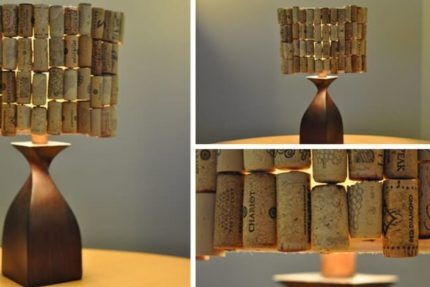
Regardless of the chosen style, you should create a homemade lampshade taking into account safety rules. During operation, the lighting device will generate heat, so there must be a distance between the lamp and the material, otherwise a fire may occur.
Rules for creating safe homemade products
Any factory that produces floor lamps has technologists on staff. When creating a new model of a lighting fixture, such specialists calculate the permissible distance from the lampshade material to the light bulb. In this case, the degree of heat resistance of the component components of the product, the power of the lamps, as well as other factors must be taken into account.
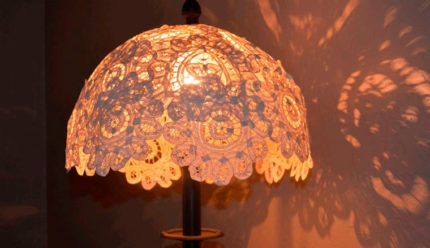
Lampshades made of fabric, paper or other flammable material should not be used together with incandescent lamps.Because they get very hot and can cause the lampshade to catch fire. We talked more about types of light bulbs in this article.
If the choice fell on LED and fluorescent lamps, you need to pay attention to them plinth. It must be of high quality. Options made of metal or ceramics are optimal. Such light bulbs will cost more than conventional ones, but they have many advantages: long service life, practically do not heat up, do not consume a lot of electricity, produce a more even stream of light and do not flicker.
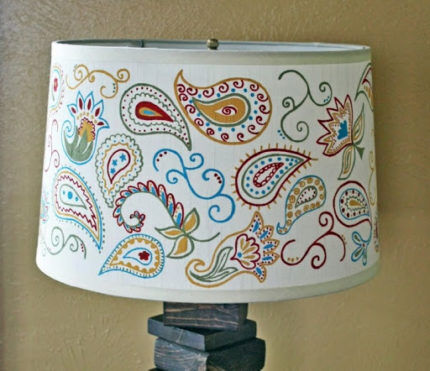
When the lampshade for the floor lamp is completely ready and the entire structure is assembled, you need to turn on the lamp and watch it work for a while to check whether the walls are heating up. If the material feels hot to the touch, you need to change the bulb to a less powerful option.
Homemade lamps can be used in the bedroom, hallway or living room. They are not used in rooms with high humidity, as there is a risk of a short circuit.
By following these rules, you can create a beautiful and safe floor or table lamp that will last a long time.
Selecting a design and assembling a lampshade
Structurally, lampshades can be divided into frame And frameless. The first option is more reliable and durable. It is easier to give the desired shape to many types of materials when there are additional stiffening ribs.
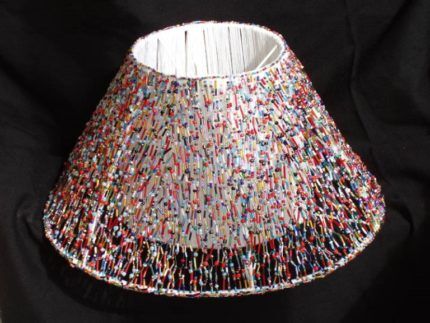
The frame can have any shape - the choice depends on the style of the room and the imagination of the master. The main thing is that the distance between the lamp and the trim of the lampshade is maintained.
Frameless variations have an original appearance and are lighter in weight. However, this model is not suitable for all materials.
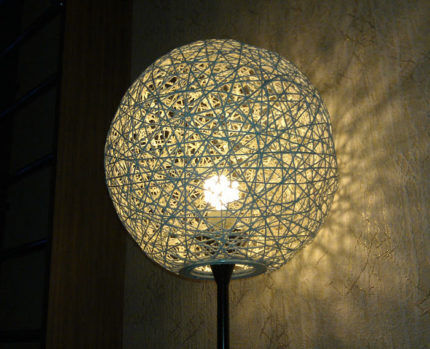
At the initial stage of manufacturing a frameless lampshade, you need to choose the right location for the light bulb. So that during assembly of the structure there is a distance between the homemade lampshade and the lamp. The service life of such products is much shorter than that of frame ones.
Manufacturing of frameless lampshades
Before creating a frameless lampshade, you need to prepare a template. This could be an inflatable ball or a balloon that you wouldn’t mind puncturing. The covering material can be knitted napkins, clothesline, yarn or thread.
Work algorithm:
- The ball or ball must be well inflated and fixed in one position. To do this, you can use a bowl of suitable diameter.
- Impregnate the material for the lampshade with PVA glue.
- Place the material on the ball. Be sure to leave a hole under cartridge (it is better to frame the hole with a plastic ring).
- When the glue is completely dry, punch and pull out the ball. The shape of the lampshade will remain the same.
Carefully insert the lamp socket into the hole left and attach the lampshade to the rod.The rod can be used from an old floor lamp or made independently from various materials: wooden cuttings, a tripod, metal rods, etc.
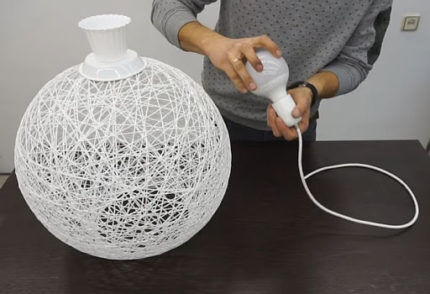
The color of the finished lampshade can be changed using spray paint. Although you can do without dyeing - threads and twine in natural colors also look good.
Ideas for making frame lampshades
If you have an old frame from a floor lamp, then that's half the job done. You just need to choose the design style of the lighting fixture and update the design. For these purposes, you can use various fabrics and materials.
Successful material options for covering lampshades:
- Textile – preference should be given to natural types. Synthetic options fade quickly and can melt when heated.
- Rope – well suited for covering frame versions of lampshades. It is possible to choose the thickness of the string.
- Yarn – applicable for classic floor lamps. Typically, yarn with a thread thickness of 1-5 mm is used.
- Ribbons – can be used to decorate a finished lampshade, as well as for weaving around a frame. They have a wide range of colors.
- Wooden elements – to make lampshades, various slats, branches and boards with perforations are used.
- Paper and cardboard – allow you to make decorative parts for decorating lighting fixtures. This is one of the cheapest design options. This lampshade can be changed at least every month.
Even the most unexpected elements can be used to create a lampshade, for example, watch gears, buttons, kitchen graters, metal cans and other improvised materials.
In the gallery below you can see a photo selection of interesting design ideas:
The given design options are suitable for updating old floor lamps that still have a frame. If the metal base is destroyed, you will need to make it yourself.
Making a frame for a lampshade
The frame can be made of steel wire with a diameter of 3 mm or more. The joints of the structure are welded using spot welding.
But this method is labor-intensive, and a welding machine is not always at hand.
Have you decided to use welding, but do not know how to use the machine? We recommend that you read nuances of welding seams.
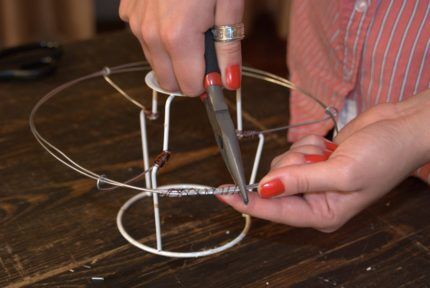
A frame twisted from several types of wire, no matter how hard you try, will not have an ideal shape. Of course, it can be decorated in a loft style and the floor lamp can be used only in the country house. However, such a lampshade is not suitable for a cozy home living room.
It is easier to work with aluminum wire; it is soft and easy to deform. With its help you can “twist” a frame of almost any shape. But the lampshade will not have good rigidity. If dropped or otherwise accidentally damaged, it will lose its shape.
If it is not possible to buy a ready-made metal frame for a lampshade, you need to look for alternative options - materials and products that are inexpensive or available at home.
Option #1 - trash can
It's easy to make a frame from a metal waste basket. If the size and shape of the product are suitable, you can begin to design.
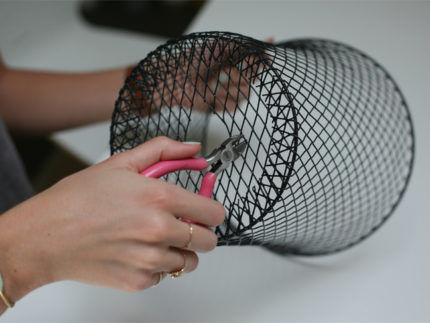
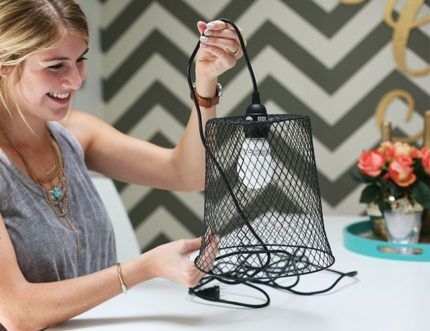
The base of the lampshade should be decorated based on the overall style of the interior.

A basket floor lamp can be decorated with colorful cable ties, leather cords and other materials.
Option #2 - metal mesh
You can buy mesh at a hardware store. The product is available in several size variations, differing in cell size.
For a floor lamp, it is most convenient to use the option with cells of 20×20 or 15×15 mm.
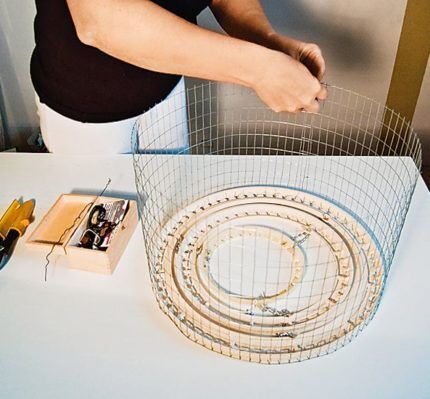
Metal mesh is suitable for creating a frame in the form of a cylinder. You can also twist it into a truncated cone. It is problematic to create other forms.
Option #3 - grille from an old fan
The fan grille is an ideal frame for a lampshade. It already has the desired spherical shape. If desired, the structure can be made deeper. To do this, an additional tier is tied to the bottom of the lattice.
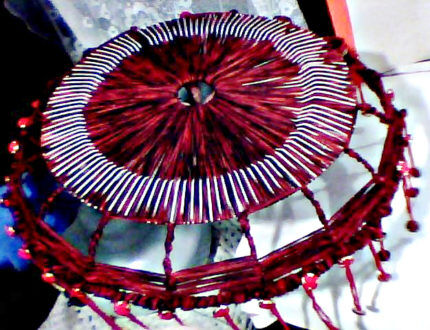
Before you start decorating the lampshade, you need to put the old grille in order. If there are traces of corrosion, clean the metal with sandpaper and only then can you apply paint.
Instructions for making a fabric lampshade
First of all, you need to prepare the material and tools. The easiest way is to make your own lampshade for a cone-shaped or cylindrical frame.
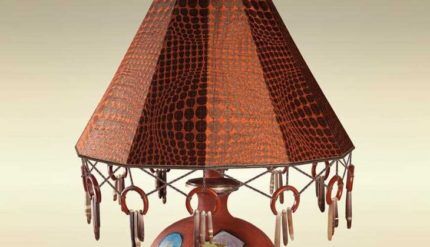
The wire frame must be coated with paint and dried. Its rods are wrapped with cotton tape and only then covered with fabric. It is advisable to sew the lampshade on a sewing machine, so it will look neater.
In addition to fabric, you will need:
- kraft paper (can be replaced with whatman paper);
- fabric glue;
- pins and threads;
- a simple pencil;
- ruler;
- iron.
First they make a pattern. It will help you cut off the required amount of material.
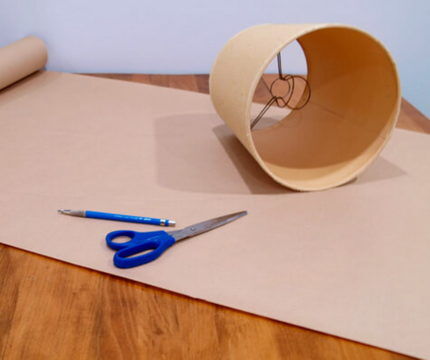
To make a cylindrical frame pattern, first measure the circumference and draw one line, and then measure the height and draw a second line. Next, two more sides are drawn and a rectangular template is cut out.
Before cutting the fabric, it is better to double-check the dimensions of the template. To do this, the rough pattern is applied to the frame; if it is larger, the excess paper is cut off.
The material can be attached to the correct template.The pattern should be applied from the wrong side of the fabric. Fix its position with pins.
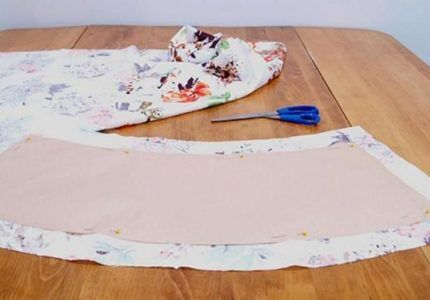
The template is outlined along the outline with a pencil (chalk for dark fabrics). After this, allowances are drawn - 1.5-2 cm from the border of the pattern. These allowances are then folded inward, and the fold lines are secured with pins and the craft paper is removed.
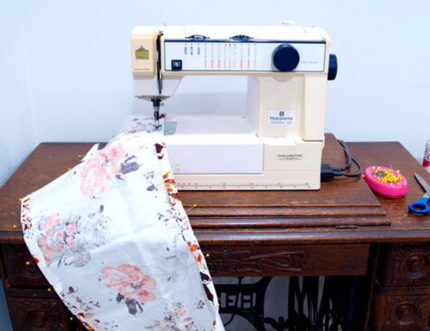
The finished workpiece must be smoothed with a hot iron. The fabric must be perfectly flat, otherwise it will not stick to the base properly.
Next, glue is applied to the fabric and glued to the frame. It is imperative to hide unprocessed cuts. If the fabric blank is attached to a metal base wrapped with tapes, then only those areas that come into contact with the frame are treated with glue.
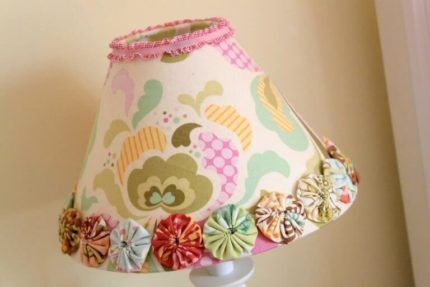
The fabric lampshade is ready. Along the edges it can also be decorated with additional decorative elements - flowers, bows, butterflies.
Conclusions and useful video on the topic
Step-by-step instructions for creating a lampshade with your own hands can be seen in the video below:
To make a lampshade with your own hands, you don’t need special skills or a lot of money. It is interesting to design a floor lamp from scrap materials, for example, cotton fabric, bottle caps or paper.
The easiest way to update an old floor lamp with a frame is to just cover it with bright material on top.Although choosing an alternative base for the lamp is not particularly difficult. This could be a metal trash can, a grille from an old fan, or a construction mesh.
Do you like to make interesting and useful homemade products from scrap materials? Or have you recently updated your floor lamp shade and want to show the results of your efforts to other users? Add original photos and share interesting ideas in the comments block located below the article.



